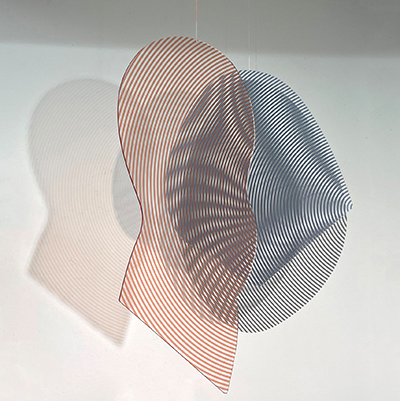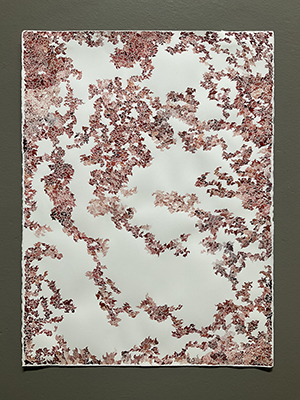
The Australian Research Council Centre of Excellence for Engineered Quantum Systems (EQUS) Quantum Art Competition has announced the two winners for 2022, following a record-breaking submission of 45 entries from talented artists.
This year’s theme was ‘Emergence’, and the first prize was awarded to Bori Benko for her artwork titled ‘EMERGENCE’.
The second prize goes to Sandy Lidgett for her artwork, ‘Demon in the Machine’. Bori receives AU$3,000 for the winning entry and Sandy receives a second winner prize of AU$1,500.
Eight shortlisted candidates are eligible for the People's Choice vote, which will open soon.
The winners were chosen by an expert panel of five external judges;
- Jill Scott; Professor for Art and Science Research at the Institute of Cultural Studies in the Arts, Zürich University of the Arts.
- Marille Hahne; Professor in Filmmaking at the University of the Arts (ZHDK) in Zürich, Switzerland and Documentary Filmmaker.
- Andrea Morello; Scientia Professor of Quantum Engineering at the University of New South Wales.
- Paul Thomas; Professor of Fine Art, UNSW Art and Design.
- Andrea Rassell; Filmmaker, media artist, and interdisciplinary researcher in science art (Forrest Fellow affiliated with the University of Western Australia).
Bori Benko’s artwork, ‘EMERGENCE’, explores and celebrates the fascinating phenomenon of the moiré interference pattern. The patterns are created whenever one semitransparent object with a repetitive pattern is placed over another. Bori's inspiration for her artwork comes from how the phenomenon of moiré interference relates to the overlapping of human mental, emotional, and physical vibrational patterns:
"Art and quantum physics are two very complex realms and approaches to human inquiry about the world. When done successfully, they can influence us to see the world in a different light; can change our fundamental truths," she explained.

Sandy Lidgett was awarded second prize for her artwork, ' Demon in the Machine’, a watercolour on paper. The work experiments with the emergence of shapes dictated by other shapes around them. Sandy's approach to the Competition theme is based on her background in biochemistry:
"I'm interested in how the concept of emergent complexity relates to living systems that defy the second law of thermodynamics. Studying biochemistry humbled me into realising that the reductive way we have of looking at living systems is limiting, especially in terms of tertiary and quaternary protein conformation and membrane function."
Professor Marille Hahne, was impressed by the winners’ interpretation of the theme:
“Bori Benko makes an interesting exploration about moving interface patterns that can contribute to the idea of emergence. It is a skilled production which can fascinate the viewers and make them think about the complexity of light and interference patterns. The shape that reminds us of a human head tends to distract one from concentrating on the hole phenomenon. Sandy’s interpretation of the theme emergence is not obvious at first sight. However, the painted shapes are mesmerising and are reminiscent of leaves that have randomly fallen onto the ground. With the theme of emergence in mind, many thought-provoking ideas can be associated with this painting. The originality of this artwork is very high and very skillfully executed," she said.
Professor Andrea Morello also enjoyed the visual appeal created by the movement of Bori’s work and Sandy’s interpretation of the theme related to biological processes.
“Bori did a great job at showing, in an almost tangible way, the concept of emergence, to be understood as a property of a large system that emerges in nontrivial ways from properties of its microscopic constituents. The way the forms move and create a visual appeal, starting from a fine comb of lines on a transparent platform, is very evocative of how I imagine emergence works in physical systems.
Sandy’s work was very creative in the way it interpreted the theme and related it to biological processes. It is indeed the case that biology is seen as an emergent phenomenon. The way Sandy embodied it in her artwork and the way it was produced seems very original”.
Professor Jill Scott liked the playful way Bori Benko explores the potential of interference and Sandy Lidgett’s creative approach to the scientific discussions around the theme:
“Bori Benko explores the potential of interference in a very playful way with moving Moirè interface Patterns on plexiglass shapes. The results are abstract shapes that explore the unpredictable nature of emergence. The whole sculpture is like a set of talking heads, representative of our thought patterns. The artists tell us that the images on the wall are related to the shadows of the objects and emergence occurs when the shadows create layers of light interference, with each other and with the objects in the room. Such random and unpredictable results are what often fascinates physicists about the behaviour of photons!
Sandy’s project is based on Thermodynamics and the candidate is well-read and thoughtful about the scientific discussions around this theme. However, she takes a creative approach and imagines herself as a wet room quantum computer. The artist tell us that she was using red pigment to be provocative and representative of a wet body machine as well use the process of making an actual test for her own decision-making processes. Therefore she tried to stay in a mediative state to test her decisions to build geometric form upon form and to let the information flow more easily”
The EQUS Public Engagement Committee is organising an exhibition in Sydney later this year, where the winners will have the opportunity to have their artwork displayed.
About EQUS Quantum Art Competition
The EQUS Quantum Art Competition is an initiative of the Australian Research Council Centre of Excellence for Engineered Quantum Systems (EQUS), aimed at promoting the intersection between art and science.



